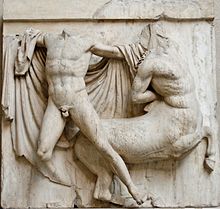
Back Mètopes del Partenó Catalan Μετόπες του Παρθενώνα Greek Metopas del Partenón Spanish Métopes du Parthénon French Métopas do Partenón Galician Metope del Partenone Italian Métopas do Partenon Portuguese

The metopes of the Parthenon are the surviving set of what were originally 92 square carved plaques of Pentelic marble originally located above the columns of the Parthenon peristyle on the Acropolis of Athens. If they were made by several artists, the master builder was certainly Phidias. They were carved between 447 or 446 BC. or at the latest 438 BC, with 442 BC as the probable date of completion. Most of them are very damaged. Typically, they represent two characters per metope either in action or repose.
The interpretations of these metopes are only conjectures, starting from mere silhouettes of figures, sometimes barely discernible, and comparing them to other contemporary representations (mainly vases). There is one theme per side of the building, representing a fight each time: Amazonomachy in the west, fall of Troy in the north, Gigantomachy in the east and fight of Centaurs and Lapiths in the south. The metopes have a purely warlike theme, like the decoration of the chryselephantine statue of Athena Parthenos housed in the Parthenon. It seems to be an evocation of the opposition between order and chaos, between the human and the animal (sometimes animal tendencies in the human), between civilization and barbarism. This general theme is considered to be a metaphor for the Median wars and thus the triumph of the city of Athens.
The majority of metopes were systematically destroyed by Christians at the time of the transformation of the Parthenon into a church towards the sixth or the seventh century AD. A powder magazine installed in the building by the Ottomans exploded during the siege of Athens by the Venetians in September 1687, continuing the destruction. The southern metopes are the best preserved. Fifteen of them are in the British Museum in London and one is in the Louvre. Those of the other sides, badly damaged, are in the Acropolis Museum in Athens, or still in place on the building.[1] Discussions between UK and Greek officials about the future of the metopes in London are ongoing.[2][3]
- ^ Titi, Catharine (2023). The Parthenon Marbles and International Law. doi:10.1007/978-3-031-26357-6. ISBN 978-3-031-26356-9. S2CID 258846977.
- ^ "Greece in 'preliminary' talks with British Museum about Parthenon marbles". The Guardian. 3 December 2022. Retrieved 4 December 2022 – via www.theguardian.com.
- ^ "British museum says constructive discussions over Parthenon Marbles". Reuters. 4 January 2023.
© MMXXIII Rich X Search. We shall prevail. All rights reserved. Rich X Search